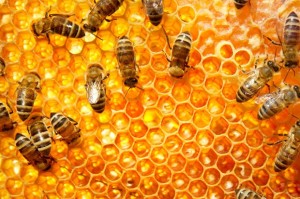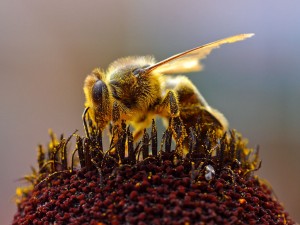 All elements of an ecosystem are crucial, and play their own distinct part in the holistic functioning of that ecosystem. If you remove one element it could cause a certain level of devastation, and the system will naturally need to make adjustments, which can be positive or negative that are outside of our control. Honey Bees pollinate 90% of all the flowering crops in the United States, and at least 30% of the worlds crops. At least one third of the food that we eat depends on pollination.
All elements of an ecosystem are crucial, and play their own distinct part in the holistic functioning of that ecosystem. If you remove one element it could cause a certain level of devastation, and the system will naturally need to make adjustments, which can be positive or negative that are outside of our control. Honey Bees pollinate 90% of all the flowering crops in the United States, and at least 30% of the worlds crops. At least one third of the food that we eat depends on pollination.
Honeybee pollination is necessary for many crops: apples, cherries, soy beans, tangerine, lemon, lime, carrots, and others. Over 100 of our food crops need this pollination, crops such as the almond tree, will grow fruit only if their flowers are cross-pollinated, making genetic exchange between two different varieties. A humbling amount of our well-being rests on the bee colonies. The pollination service provided by insect pollinators, manly bees , was 153 billion euros back in 2005, their value accounts for at least 9.5% of the total value of the world agricultural food, and are responsible for a $15 billion increase in crop value per year. Simply put, if the bees to not pollinate, we will not have these crops. But they are in decline, and there are a myriad of suspicions as to why that is happening.
So, what has been going on?
 Although it is argued that the bee colony collapse has been going on for over a decade, we know that from 1972 to 2006, there were dramatic reductions in the number of feral honey bees in the U.S. Alone, and a gradual decline in colonies overall (Watanabe, 1994). Losses have remained stable since the 1990s at roughly 22-35% per year attributable to a variety of factors, such as mites, diseases, and management stress (Johnson, 2010). The syndrome “colony collapse disorder” (CCD), by 2007, had officially been characterized as: the disappearance of all adult honey bees in a hive while immature bees and honey remain.
Although it is argued that the bee colony collapse has been going on for over a decade, we know that from 1972 to 2006, there were dramatic reductions in the number of feral honey bees in the U.S. Alone, and a gradual decline in colonies overall (Watanabe, 1994). Losses have remained stable since the 1990s at roughly 22-35% per year attributable to a variety of factors, such as mites, diseases, and management stress (Johnson, 2010). The syndrome “colony collapse disorder” (CCD), by 2007, had officially been characterized as: the disappearance of all adult honey bees in a hive while immature bees and honey remain.
It is believed that perhaps pesticides are to blame, in 2012 several peer reviewed independent studies demonstrated that neonicotinoids had previously undetected routes of exposure (such as dust, pollen, nectar) affecting bees and their health. Also, that sub-nanogram toxicity resulted in failure to return to the hive without immediate lethality, the primary symptom of CCD. Consequently, the European Union (EU) moved to ban neonicotinoid pesticides due to the fact that they might be responsible for the continued collapse. These findings also initiated a formal review by the European Food Safety Authority, which stated that neonicotinoids pose a high risk. The pesticide industry has been accused of being “deliberately deceptive” and manufacturer Bayer Cropscience has been asked to explain the discrepancies in the evidence that had been submitted to the investigation.
The bees also travel long distances in order to pollinate crops in other areas, which leads some to believe that this causes stress on their immune system and exposes them to pathogens which they are not used to. But colonies that aren’t transported are collapsing as well.
When the honey is harvested, it is also replaced with genetically-modified corn syrup, which doesn’t have necessary enzymes or nutritional content. So it is believed that perhaps genetically modified organisms also have something to do with the problem. This is potentially due to the fact that all individuals of strain of GMO are all genetically identical, and grown in monoculture, meaning the bees have a restricted and unhealthy diet. Although neocontinoids have been specifically singled out, it is likely that most, if not all, pesticides negatively affect bees. And with even fungicides lowering bees’ resistance, it isn’t a longshot to expect that Bt pollen (with an insecticide in every cell) and total herbicides like those sprayed on most GMOs, are at least partially responsible for this.
Currently, there isn’t much independently peer-reviewed data supporting direct or indirect damage to bees that is caused by currently approved genetically-modified crops. (Duan, Marvier, Dively, & Huang, 2008). It is supposed that more than likely, there are many factors at play which are contributing to the problem. But one thing is for certain: the problem is real, and hand powered electric pollinators are not the answer.
References:
Johnson, Renée (7 January 2010). “Honey Bee Colony Collapse Disorder”. Congressional Research Service.
Duan JJ, Marvier M, Huesing J, Dively G, Huang ZY. 2008. A meta-analysis of effects of Bt crops on honey bees (Hymenoptera: Apidae).
Watanabe, M. (1994). “Pollination worries rise as honey bees decline”. Science 265 (5176): 1170.
 Translate
Translate




